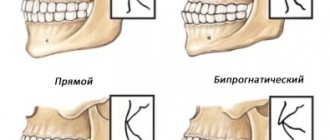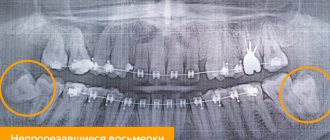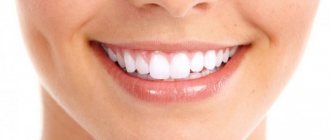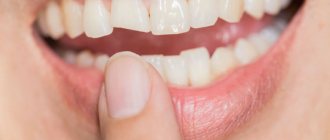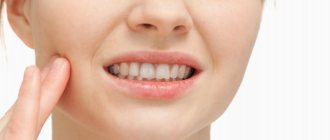Polyodontia is an abnormal number of teeth.
In medicine, this disease is often called hyperdontia, and “extra” dental elements are called supernumerary teeth. Research is still being conducted into why this pathology occurs. Most scientists associate it with disturbances in the formation of tooth germs.
Nature provides that a person grows no more than 20 milk teeth and 32 permanent teeth in a lifetime, but exceptions occur, and in our time quite often. According to statistics, on average, dental anomalies occur in 2% of the world's population, most often in men.
In 2014 alone, two operations were performed, in one of which 80 teeth were removed, and in the other, a record 232 teeth. Until this time, the maximum figure was 37 teeth.
The most common hyperdontia (anomaly in the number of teeth) is an anomaly of the upper incisors. Supernumerary teeth are less common among the lower incisors and in other parts of the jaw. They can come in a wide variety of shapes and sizes. These are usually small, cone-shaped teeth.
Extra teeth lead to deformation of the dentition, so it is recommended to remove supernumerary elements. Another reason for removal is that most patients with this pathology have a lisp.
The formation of extra teeth is quite common today. According to statistics, 70% of patients have only one extra incisor, in 25% of cases – 2 supernumerary elements, and only 5% of all patients have 3 or more teeth during examination.
Orthodontic treatment after extraction
Since the presence of supernumerary teeth for a long time has a negative impact on the normal eruption of complete teeth, it is advisable to combine their removal with subsequent orthodontic treatment. This is justified by the fact that complete teeth, having received additional space, may take an incorrect position when independently moved to the extraction zone. In such cases, the device is made before the tooth extraction surgery, but the installation of the device occurs on average 1 week - after the hole has healed and the bone tissue has been restored. This allows you to immediately begin gently moving teeth on the thinnest arch using braces.
Removing any tooth, including a supernumerary one, can cause a child quite severe psychological discomfort. That is why pediatric dentists at our Center pay great attention to the emotional state of pediatric patients. The use of certain psychological tactics allows you to cope with childhood fears and form a positive attitude towards medicine. The complete absence of unpleasant sensations during the procedure creates confidence in the dentist.
Causes of polyodontia
Medicine has not yet found an exact answer to the question of what are the causes of supernumerary teeth. Scientists put forward several hypotheses:
- Atavism. Supernumerary teeth are explained by the fact that the dental system strives to return to the original number of elements laid down by nature. There is evidence that our ancestors had 6 incisors on both the lower and upper jaws. As a result, many doctors consider atavism to be the cause of the development of polyodontia in humans.
- Splitting of the tooth germ. Even in the embryonic period, the activity of the dental plate is disrupted in the child, as a result of which hyperdontia is formed. Violations can be caused by viruses, poor ecology, drugs, medications prohibited during pregnancy, alcohol and other factors. This hypothesis is increasingly supported today, because recently the disease has been rapidly progressing due to bad habits and poor ecology.
The causes of hyperdontia continue to be researched. Scientists cannot give an exact explanation for this anomaly, but most of them are inclined to the second hypothesis - the splitting of the tooth germ at the embryonic stage.
Which animal has 36 teeth? The most toothless animals in the world
Almost all living things need teeth, with which they obtain and chew food. However, many animals can easily do without teeth or use only a small number of them. At the same time, they can live a completely full life, and some of them have existed in this “state” for many millions of years.
flickr/oppy1951
Scientists have repeatedly discovered unique animals that we are accustomed to consider as toothy creatures, but as it turned out, the main feature of the structure of their jaw was the almost complete absence of teeth, which greatly distinguishes them from all other relatives. Do they really not need teeth at all? Or maybe they have something that completely replaces them?
Chinchillas
flickr/OakZoo
Chinchillas (lat. Chinchilla) are small rodents and at the same time they get by with only 20 teeth. But at the same time they do an excellent job with food. These small animals have a very narrow oral cavity, containing 16 molars and 2 incisors. The chinchilla is a small creature and has a lifespan of about 20 years.
Three-toed sloth
flickr/Martha de Jong-Lantink
The three-toed sloth (lat. Bradypodidae) has even fewer teeth - 18 and they are brown in color, devoid of enamel and roots. In addition, they lack fangs and incisors. The molars - one on each side of the upper and lower jaw - are elongated and have a fang-like appearance, separated from the other teeth by a diastema (a special space between the teeth). The small number of teeth sloths have is compensated by hard lips.
Gerbil
flickr/ressaure
Gerbil (lat. Gerbillinae) is a small rodent, the only representative of the genus. Externally, the gerbil looks like an ordinary mouse. These rodents have only 16 teeth; the front teeth are constantly growing, as they tend to wear down. Molars may or may not have roots (every animal is different).
Wombats
flickr/www.jeroenstel.com
Wombats (lat. Vombatidae) are a mammal from the family of two-incisor marsupials. The structure of the wombat's jaws and teeth are somewhat similar to rodents. These cute and compact animals have the smallest number of teeth among marsupials - only 12.
Golden-bellied or beaver rat
flickr/Jeremy Ringma
Golden-bellied, or beaver rat (lat. Hydromys chrysogaster) - it, like the wombat, has only 12 teeth. In addition to the incisors, her jaw contains molars, and behind the large molar there is a smaller tooth. The third tooth is missing because the 1st and 2nd molars prevent it from developing.
Shrew rat
Kevin Rowe
The shrew rat (lat. Paucidentomys vermidax) is a small rodent (the size of a rat) discovered by researchers in Indonesia. This rat surprised biologists with its small number of teeth, which is why it was classified as a new genus of “small-toothed mice.” She has only four modified incisors; the rest of her teeth are simply missing. Such a small number of teeth and the structure of the jaw was due to the monotonous diet of these rodents - they eat only worms and slugs, and can consume fruit pulp.
Indian pangolin
flickr/Raoul Rutnam
Indian lizards (lat. Manis crassicaudata) are a mammal belonging to the order pangolin. These lizards feed on termites, ants and their eggs, which is why they lack teeth (as they are unnecessary). But they have a tongue - 23-25 cm in length. It is with this tongue that the lizard captures and pushes food into the throat. The length of its tongue is almost half the length of its body.
Turtles
flickr/pixburn
Sea and land turtles are devoid of any teeth, they are replaced by horny plates similar to a beak. With this “beak” they can easily bite a stick with a diameter of up to 2-3 centimeters or a person’s finger. Interestingly, millions of years ago there lived turtles that had teeth in their mouths.
Baleen whales
flickr/flythebirdpath
Baleen or toothless whales (lat. Mysticeti) - the name speaks for itself - it indicates the complete absence of teeth. Instead of teeth, in the mouth of this mammal there is a whalebone - horny plates that are located in rows on the palate and on the upper jaw. These plates are of different lengths, depending on their location in the oral cavity. With the help of these plates, the whale filters the water, leaving behind various crustaceans, plankton and small fish.
Anteaters
flickr/wandering tattler
Anteaters also lack teeth. In their elongated and narrow mouth, only a long and sticky tongue fits - a “tool” with the help of which the anteater obtains food for itself - ants and termites - its favorite delicacy.
As you already understand, the structure and number of teeth indicate what the animals eat. If living creatures have no teeth or their number is small, this means that they are not necessary or they have other ways of consuming food.
What does polyodontia look like?
Quite often, extra teeth are almost indistinguishable from normal ones. It is not uncommon for them to grow in the form of a drop or a thorn. These dental elements can appear either individually or fused with permanent ones. They can form tooth-like formations and entire arrays of teeth.
Also in medical practice, there are cases where polyodontia was hidden and was detected only by radiography. There are many different cases of abnormal development of the number of teeth, and if you notice symptoms, you should definitely contact the dentist.
Types of polyodontia disease
Polyodontia in the oral cavity manifests itself in different ways. By studying the statistics, signs and symptoms of the disease, dentists were able to classify the types of this anomaly.
Depending on the origin, the disease is divided into two types:
- False polyodontia. Provides for a baby tooth that does not fall out, regardless of the person’s age. At the same time, it fulfills its functions, does not create discomfort to the bite, and is firmly fixed in the patient’s jaw. In addition, teeth fused together and other anomalies are classified as a false type of disease.
- True polyodontia. It can be caused by genetic predisposition, as well as terogenic factors. At the same time, extra molars begin to form in the human jaw.
Kinds
Supernumerary teeth can be located:
- in the dentition with a change in the correct position of normal dental elements;
- in atypical places (dystopic teeth), for example, on the palate or on the front surface of the gums;
- in the bone tissue of the jaw and do not erupt into the oral cavity (impacted).
Depending on the shape of the crown, supernumerary teeth can be of several types:
- lumpy;
- spiny;
- chisel-shaped;
- pineal;
- split;
- fused.
As for the placement of extra teeth, dentists distinguish the following types of disease:
- Typical hyperdontia. Applies to those patients in whom extra teeth appear only in the dentition and do not extend beyond it. Many scientists are confident that this is simply heredity, because our ancestors had a more developed dental system than modern people.
- Atypical hyperdontia. It occurs much less frequently and is characterized by the appearance of teeth outside the dentition.
In case of anomalies with baby teeth, the latter pose almost no threat. On the contrary, such a tooth can last a lifetime. But the permanent molars, over which the supernumeraries grow, should be removed, if only because it is not aesthetically pleasing.
Often, the patient grows extra fangs or incisors, or even several front teeth at once. In addition to a ruined smile, the disease can cause serious complications if the necessary measures are not taken in time.
Where can extra teeth appear?
Supernumerary teeth can erupt in or outside the dentition. Then, for example, they grow on the palate above the tooth or on the side of the gum. And if a child has a lot of supernumerary teeth, then they can grow in two rows.
The most common places where polyodontia appears are the areas of the upper central incisors, as well as the molars, premolars and canines of the upper jaw. Supernumerary teeth are much less common in the lower jaw.
What can the presence of supernumerary teeth lead to?
- retention of normal teeth
- loss of permanent units
- malocclusion
- mucosal injury
- problems pronouncing sounds
- resorption of the roots of complete teeth
- development of a jaw cyst from a supernumerary tooth bud.
Symptoms of the disease in children
The first supernumerary teeth in children appear before birth or in the first six months of life. The main inconvenience they cause is difficulty in feeding.
Polyodontia of primary teeth in older children occurs with symptoms similar to the eruption of regular teeth. In this case it is observed:
- temperature increase;
- swelling of the gums in the place where the tooth should erupt;
- pain;
- excessive salivation;
- swelling of the nasal mucosa;
- loose stool.
Symptoms are especially severe when extra teeth appear in the upper palate.
If hyperdontia makes itself felt in a two-year-old child, this can interfere with the formation of normal speech. In turn, due to injury to the tongue and mucous membranes, some kind of inflammation constantly appears in the oral cavity.
When supernumerary teeth appear in very noticeable places in school-age children, ridicule towards the patient may occur, which is fraught with the development of psychological problems and complexes in the future.
Types of supernumerary teeth
Extra complex teeth can have several edges, be cone-shaped or have other shapes. In rare cases, they have the correct tooth shape.
According to the shape of the crowns, teeth are:
- spinous - the crown has the shape of a sharp cone;
- chisel-shaped - the crowns of the teeth are flattened;
- tuberculate - the crown is covered with tubercles and pits;
- fused - supernumerary teeth are connected to complete teeth in the root, crown part or throughout.
If supernumerary teeth have a well-developed root and formed periodontium, then they erupt very intensively. Extra teeth are located both in the dental arch and outside the dentition; they often disturb the arrangement of complete teeth. Supernumerary teeth appear simultaneously with permanent teeth, or slowly, one after another.
There is such a type of polyodontia as false, or pseudopolyodontia - when an adult retains milk teeth after the appearance of permanent teeth. There are known cases of detection of baby teeth in patients aged 50-60 years.
Symptoms of hyperdontia in adults
Polyodontia affects permanent teeth more often than baby teeth. An adult usually develops dystopic and impacted supernumerary teeth.
Dystopic teeth are those that appear outside the dental arch. Most often they erupt on the lingual surface of the gums and in the palate. With this form of the disease, the patient typically:
- poor pronunciation of sounds;
- noticeable malocclusion;
- change in the usual arrangement of teeth: curvature of the angle at which they grow, as well as their rotation
- around its axis;
- frequent injury to the oral mucosa and, as a result, its inflammation;
- disruption of chewing processes, resulting in digestive problems.
Among other things, dystopic teeth often cause psychological problems. Due to a non-aesthetic, and sometimes completely unattractive smile, the patient becomes withdrawn and uncommunicative. Psychological problems, in turn, cause chronic diseases of the endocrine, digestive and nervous systems.
Impacted supernumerary teeth are teeth that do not erupt, but continue to remain in the bone tissue of the human jaw. Often they hardly make themselves felt until complications begin. Dentists diagnose this anomaly during a routine examination of the patient.
This abnormality in the number of teeth is accompanied by the following symptoms:
- normal teeth begin to loosen (the condition is considered pathological);
- the bone begins to protrude (if the impacted tooth is too close to the edge of the jaw);
- Aching pains appear periodically.
One of the most difficult situations is when extra teeth grow in place of impacted third molars. Wisdom teeth cannot grow and begin to negatively affect the roots of other teeth, which in turn can lead to serious complications.
Consequences of polyodontia disease
Polyodontia in humans can often be the cause of retention. This is a phenomenon in which normal teeth are unable to erupt due to the interference of supernumerary teeth. The former may remain in the jaw or take an abnormal position.
In addition, even if the complete incisor grows before the supernumerary one, the latter will be able to displace it. This will lead to the person being unable to chew food normally. And if several extra incisors grow at once, they can cause the loss of permanent teeth.
How polyodontia reveals itself
In children, this anomaly, established in the womb, manifests itself in the first six months of the child’s life. Polyodontia can be asymptomatic or with the same signs as the eruption of regular teeth. That is, the following are observed: moodiness due to increased body temperature, swelling, sensitivity and soreness of the gums, excessive salivation, swelling of the nasopharynx, disturbances in stool (most often diarrhea). Parents should be concerned about the unusual shape of the emerging tooth and be wary of its location, usually outside the standard dentition. To identify hidden polyodontia in children, doctors recommend examination at the age of six, using computed tomography or panoramic x-ray examination. In this way, it is possible not only to identify the presence of teeth beyond the norm, but also to check whether the child has all the rudiments of permanent teeth.
In adults, manifestations of anomalies may be absent, and supernumerary teeth may not appear on the surface of the gums. But if they erupt, they will create inconvenience, disrupt bite and diction, injure the gums or interfere with the normal position of the normal dentition. It happens that an extra impacted tooth, which “sleeps” in the gum (or even in the jaw bone), loosens permanent teeth or deforms bone tissue.
Diagnostics
Examining supernumerary teeth during an x-ray is not as easy as it seems. They can be superimposed along the contour onto the permanent ones and remain invisible. In such cases, patients are recommended to undergo a computed tomography scan, which shows a more accurate picture of the disease.
If the extra dental elements have already erupted, the dentist can easily detect them. In practice, the patients themselves find the erupted supernumerary teeth and already at the initial appointment with the dentist they complain about the pathology.
Molars - normal or abnormal?
Speaking of molars! Why do some have them and others don't? And why is both their absence and their presence considered the norm?
The study of the evolution of molars shows that they are facing imminent extinction - complete disappearance from the human mouth. Once upon a time, the human jaw could accommodate as many as 44 teeth, today there are 32, but a tendency towards reduction is observed, which is due to soft food. A few hundred years and molars can completely disappear. Some modern people never have them!
It turns out, from the point of view of modern dentistry, the number of teeth in a person’s mouth from 28 to 32 is considered the norm. If you have a full set of teeth (32), we congratulate you on reaching the norm. But in practice, only a select few reach the standard of a complete set!
Symptom relief
Most often, in adults, extra teeth erupt without any symptoms, but for children this can become a problem that needs to be addressed.
Supernumerary teeth erupt with the same symptoms as regular teeth, so the treatment for them is the same.
- To lower the temperature, it is recommended to give your baby Paracetamol or Ibuprofen. If the child is very small, these drugs can be used in the form of suspensions or rectal suppositories. In addition to lowering the temperature, these medications do an excellent job of treating pain and inflammation.
- To relieve gum pain, local anesthetics are used - ointments and gels (for example, Kalgel, Dentinox, Solokoseryl). These remedies cope well with painful sensations and slightly relieve inflammation.
- Adults and children over 2 years of age can be treated with folk remedies: propolis, honey, decoctions of calendula, chamomile and lemon balm. Some decoctions help reduce pain and relieve inflammation. Traditional methods of treatment should be used only after consultation with your doctor.
- If primary supernumerary teeth have partially erupted, stimulation of eruption is prescribed. For this purpose, vibration and electrical stimulation, as well as special massage, are used.
Normal deletion
If the dentist decides that in a particular case, polyodontia can only be treated by removing an extra tooth, the patient should count on the following procedures:
- First of all, the patient should be sent for radiography. This is necessary in order to determine the size and number of roots, as well as the ratio of supernumerary and normal teeth.
- After collecting research, the doctor gives the patient anesthesia and removes excess teeth.
- In some cases, soft tissue sutures may be necessary after surgery.
Why is it difficult to calculate the exact number of teeth?
Dental X-ray allows you to find out the exact number of teeth.
How many teeth do you have? This question may also seem simple: now let’s calculate and find out! But a surprise may await you. After all, the number of roots and canals may differ due to the fact that the latter very often bifurcate near the pulp.
It also happens that several canals are located in parallel in one root and only an x-ray will help you calculate the exact number of teeth in your mouth!
To accurately count everything in a tooth, dentists at YuliSTOM clinics use x-rays. This allows you to avoid incidents during dental treatment!
Removal of impacted teeth
In order for the operation to be successful and polyodontia to be cured without any complications, the doctor must fully examine the patient and plan his further actions.
- To begin with, X-rays and/or computed tomography are performed to determine the exact topography of the anomaly.
- Removal is performed under local anesthesia, but there are cases when general anesthesia can be used on the patient.
- First, the mucous membrane is peeled off, then the bone tissue is opened and the root and crown parts of the tooth are removed.
- If necessary, bone defects are covered with osteoplastic material, and the mucous membrane is sutured.
After tooth extraction, the patient continues treatment at home: takes antibiotics (if prescribed by the attending physician), rinses the oral cavity with antiseptic solutions.
Until the wound heals after surgery, it is not recommended to eat too hot, hard or spicy food. You should also brush your teeth carefully, especially on the operated side.
Treatment
Treatment depends on a number of factors: the location and inclination of the tooth, the influence of the supernumerary tooth on the rest of the dentition, etc. The supernumerary tooth is removed:
- if the tooth has erupted in place of the molar;
- in a situation where a supernumerary tooth affects the formation of the bite;
- if it has not fully erupted and grows under the gum incorrectly, at some angle.
Quite often, after the removal of a supernumerary tooth, it is necessary to undergo orthodontic treatment to correct the bite or straighten the dentition. The entire procedure is performed under local anesthesia, so it is practically painless for the patient. The anesthetic is selected based on each specific situation, as well as the general condition of the patient and his age. After the removal of a supernumerary tooth, the patient is observed by a specialist during the first weeks, attending regular examinations. Also, if necessary, your doctor may prescribe a course of antibiotics. If you follow all the advice of a specialist, within a few days after removal, the person will be able to return to their normal lifestyle.

